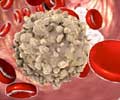For the very first time, CAR T cells battling a tumor were visualized by scientists. The precise function of CAR T cells in a bid to optimize future therapies discovered.

‘Chimeric antigen receptor T cells (CAR T cells) represent a promising immunotherapy strategy, developed with the aim of tackling tumors head-on. ’





One of the strategies used to combat cancer is based on modification of the patient's T lymphocytes (also known as natural killer cells) to make them recognize the target molecule CD19 expressed by the tumor, so that they can eliminate it. Clinical trials have proved to be remarkably effective, leading to the use of this technique in adults and children to treat blood cancer (B-cell lymphomas and leukemia). But some patients suffer relapses. To improve therapies in future, scientists from the Institut Pasteur set out to elucidate the precise workings of CAR T cells. The inner workings of immunity
Using a novel high-resolution in vivo imaging technique, they observed the bone marrow of mice with lymphoma. This enabled them to investigate the overall behavior of CAR T cells and to visualize in real time the interactions between CAR T cells and the tumor, as well as tumor death (imaged using an ingenious technique that changes the color of cancer cells after they die). Even if some CAR T cells are more active than others, they demonstrated that in general, a CAR T cell is capable of directly killing a tumor cell within approximately 25 minutes of recognizing its target.
The key role of CAR T cells in the fight against cancer
"Mathematical simulations based on our experimental data confirm that the efficacy of CAR T cells is primarily based on their ability to engage and directly kill the cancer cell rather than recruiting other immune cells to the tumor site," explains Philippe Bousso. These simulations also demonstrated that the number of CAR T cells that are able to infiltrate the bone marrow plays a major role in treatment efficacy.
Advertisement
Advertisement
"By identifying the strengths and weaknesses of CAR T cells in action, this research opens up new avenues for exploiting and optimizing the activity of CAR T cells in patients," concludes Philippe Bousso.
Source-Eurekalert














